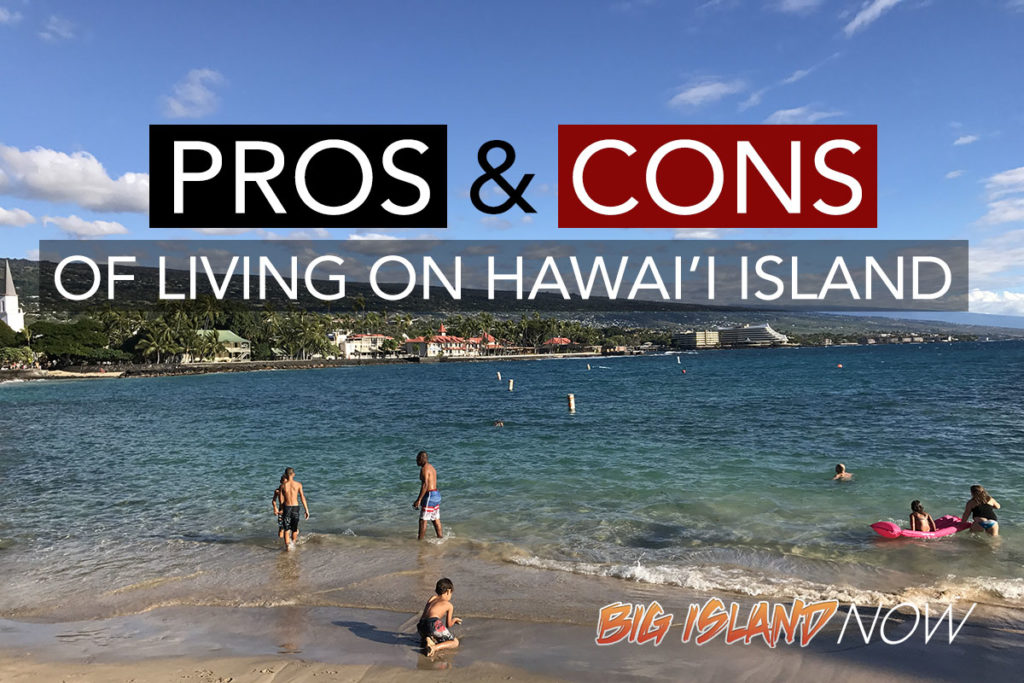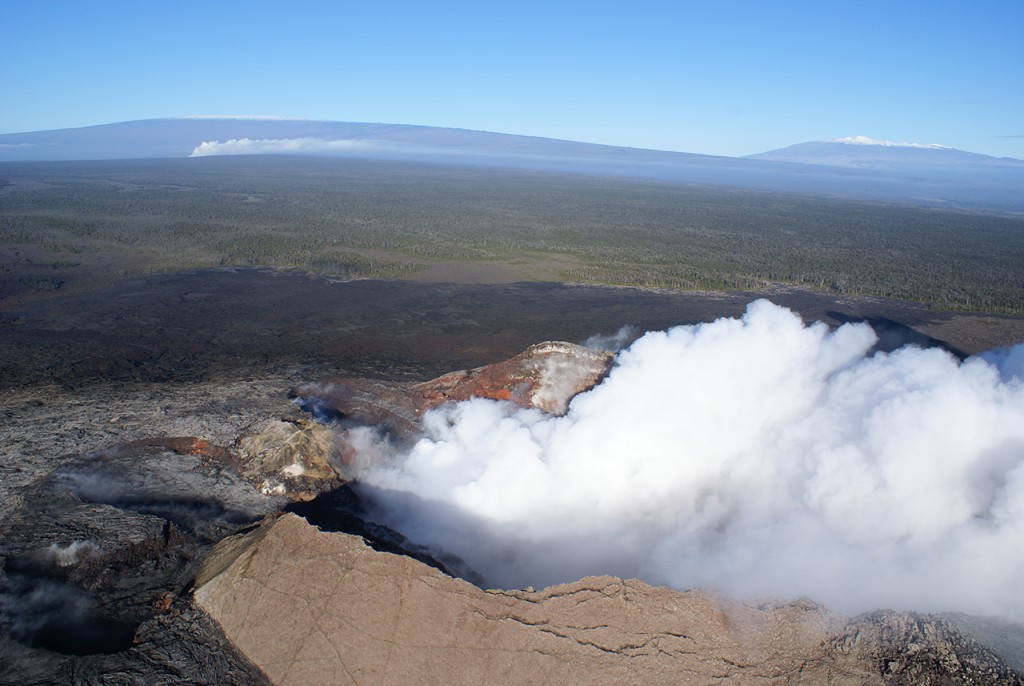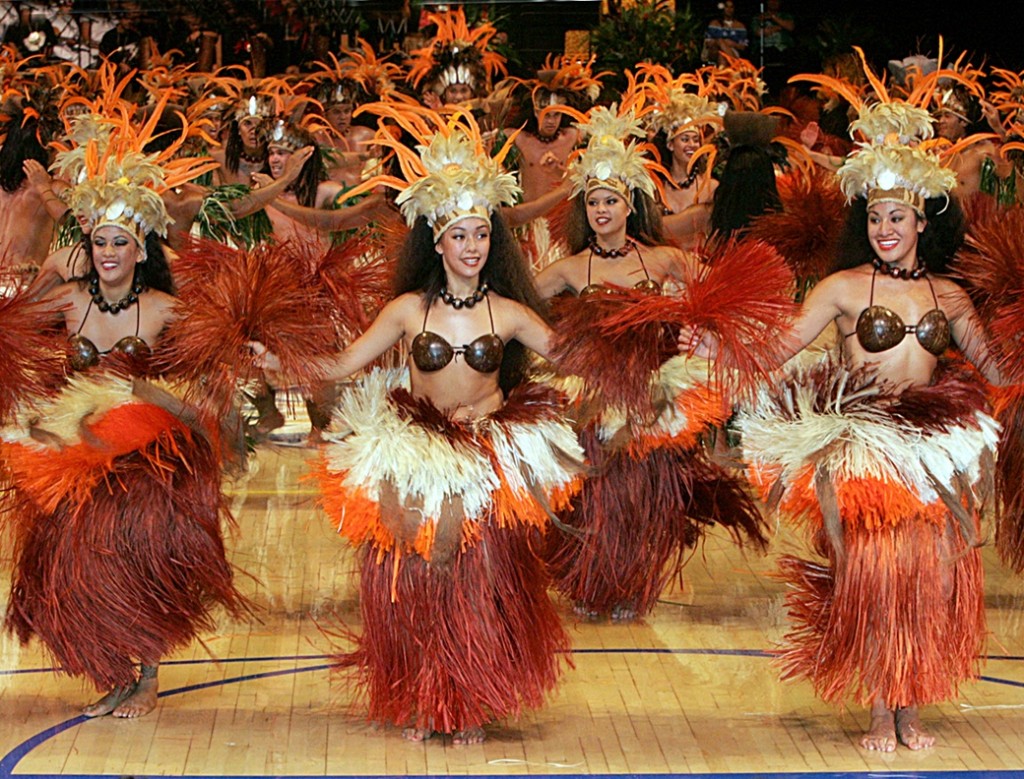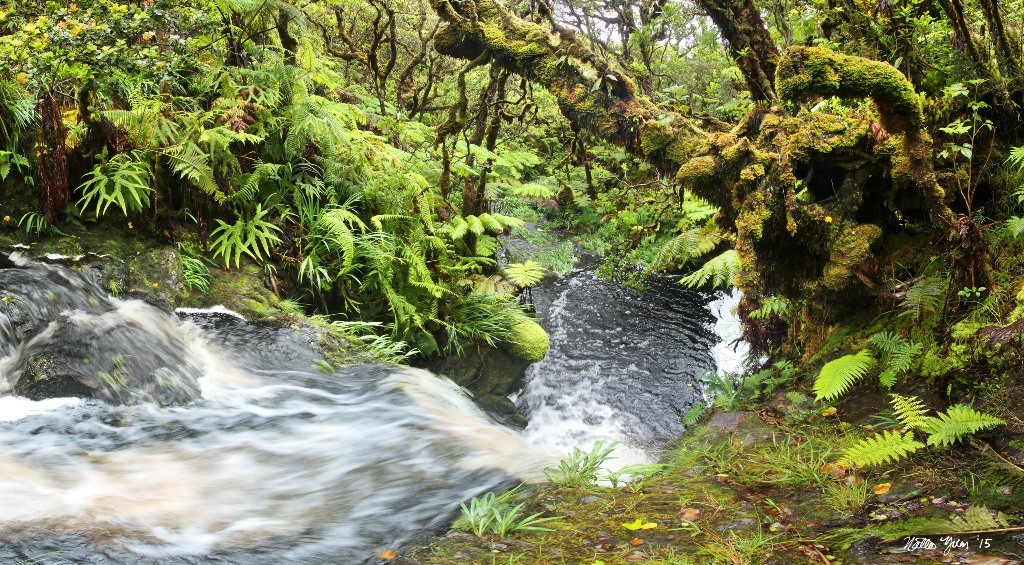The Pros and Cons of Living on Hawai‘i Island
So, you are thinking about moving to the Big Island (formally called Hawai‘i Island)?

Maybe you’ve visited the Orchid Isle several times; maybe you’re taking a courageous leap and want to move here sight unseen.
The Big Island is indeed a magnificent and powerful place. Active volcanoes, tropical jungle, waterfalls, towering mountains and idyllic beaches call an alluring siren song—it’s an easy place to fall in love with.
However, vacationing on the Big Island and actually living here are vastly different. Many an unwary newcomer moves here with dreams of living in paradise, only to discover the realities of island life clash with their imaginings. Don’t let this discourage you from your dreams. Living on the Big Island can be a veritable nirvana, especially if you educate yourself so you don’t experience any unanticipated surprises. That said, there’s a number of pros and cons to living on the Big Island.
The Weather

The west side is blanketed with black lava flows. These basaltic masses absorb the sun’s rays, and as a result, the Kailua-Kona area can be extremely hot. USGS photo.
The Pros: With 11 of the world’s 13 sub-climates, you can find just about any kind of environment you desire to live in. The west, or leeward side, is dry; the eastern windward side is wet. It’s colder in the high elevations, and grows warmer the closer you get to sea level.
The Cons: The west side is blanketed with black lava flows. These basaltic masses absorb the sun’s rays, and as a result, the Kailua-Kona area can be extremely hot. The leeward side often experiences severe droughts that generate water usage restrictions. Wildfires are common.
Additionally, with the renewed eruption of Kīlauea in 1983, the leeward-side atmosphere is usually permeated with vog. Vog is airborne volcanic emissions consisting of sulfur dioxide and other noxious volcanic gasses. Those with respiratory issues or chemical sensitivities should not live on the leeward side. The rest of the island does not see (or breathe) as much vog.
The highlands and the eastern side experience a lot of rain—“lot” being the key word—and that means mold. Everything on the windward side, even wooden furniture, grows mold unless it is cleaned regularly.
Did I forget to mention that we also get hurricanes and tropical storms?
Cost of Living

Educate yourself on where the grocery deals are, hit the farmer’s markets and take advantage of the numerous secondhand stores on the island. Photo credit Denise Laitinen.
The Pros: By educating yourself on where the grocery deals are, hitting the farmer’s markets and taking advantage of the numerous secondhand stores on the island, you can get by at a decent price for food and creature comforts. Hawai‘i County operates re-use centers at almost every transfer station (I’ll get to what those are later) and you can find really good stuff at them for super-cheap.
The Cons: Aside from what’s mentioned above, living anywhere in Hawai‘i is expensive. If you want to rent a place on the Big Island, you’ll be hard-pressed to find even a studio apartment with a stove for under $700 per month. Gasoline, propane and electricity prices are some of the highest in the nation. The cost of auto insurance is astronomical, usually around $1,200-plus per year or more, and that’s if you have a perfect driving record and don’t smoke. Annual auto registration fees are likewise sky high.
Touching again on the subject of groceries, be prepared to pay anywhere from $5 to $7 for a loaf of bread, $3 or more for a can of soup… you get the idea.
The Infrastructure

For those who want to utilize public transportation, there is an excellent bus system that runs across the entire island. Photo credit: Office of the Mayor.
The Pros: All in all, Hawai‘i County keeps up the roads quite well; for those who want to utilize public transportation, there is an excellent bus system that runs across the entire island. As far as areas with good accessibility and convenience, the historic town of Hilo is very user-friendly, with numerous parks and bike paths, and a wonderful, compact downtown area.
The Cons: Traffic. Especially during rush hour—and most especially in Kona, Hilo and the 10-mile stretch between Kea‘au and Pāhoa in the Puna District. The roads simply weren’t built to handle the increasing amount of vehicles on them. That brings us to road construction. There’s always construction somewhere, usually on a road where there is no other route to get to where you’re going. In short, expect significant traffic delays anytime, anywhere. (Check BigIslandNow.com for weekly “Scheduled Road and Lane Closure” announcements.)
Another infrastructure drawback is water supply. The majority of the Big Island is reliant on private rainwater catchment systems, except in municipalities like Hilo and Kailua-Kona. This means each home has its own catchment system, and if there’s no rain for a while, you’re not going to have running water unless it’s trucked in, which is very expensive.
There is no rubbish pickup except in Hilo and Kona proper. You have to haul your rubbish to a local transfer station to dump it, and from there the county hauls refuse to the main landfills. But during your transfer station run, you can shop and replace the stuff you get rid of with more stuff from the re-use centers.
Excepting Hilo and Kona, there is no home mail delivery, though we do have UPS and FedEx for home delivery of packages. You will have to get a post office box and in a few areas there is a waiting list for them. The good news is that if you can prove you are residing within the zip code jurisdiction (lease, utility bills, etc.) there is no charge for a post box.
Island Culture

Local island culture is very different from anything you are used to. It’s important to remember that Hawai‘i is not “America.” It is Polynesia. Photo courtesy of The Tahitian Culture Festival.
The Pros: For the most part, the Hawaiian culture is warm and fun loving. Many kama‘āina (transplants who have been here for a long time and know the island ways) have adopted the Hawaiian culture and a modicum of the Hawaiian language. You’ll find most Hawaiians, locals (Hawai‘i-born people with mixed or no Hawaiian bloodlines) and kama‘āina to be very hospitable, especially if you are making a genuine effort to understand and respect local ways and customs.
The Cons: Local island culture is very different from anything you are used to. It’s important to remember that Hawai‘i is not “America.” It is Polynesia.
Initially, expect to be met with suspicion, indifference or both, though this will dissipate as you become more versed in the culture and show respect for it. Also, Hawai‘i is very racist, especially the Big Island. Caucasians here are known as haole, and depending on the context, use of that word is usually not a compliment. Frankly, it’s evident in attitudes and conversations that most locals are weary of the huge influx of newcomers.
You will find that we are very protective of our lands and culture and take great pride in the language.
A bit of advice: learn as much as you can about Hawaiian culture, history and language before you move here. Learn proper Hawaiian pronunciation. It will go a long way.
Safety and Security

Major violent crimes such as murder and armed robbery are few, and many neighborhoods have very good Neighborhood Watch programs. Big Island Now stock photo.
The Pros: This is an island, so if someone commits a serious crime, it can be pretty hard to disappear. Major violent crimes such as murder and armed robbery are few. Many neighborhoods have very good Neighborhood Watch programs, and in most places it is safe to walk down the street alone at night.
The Cons: There is a serious crystal methamphetamine problem on the Big Island, which has resulted in a tremendous amount of theft. House burglaries are very common—in some areas more than others. Get the police crime statistics for any neighborhood you are considering moving to. (Check BigIslandNow.com for weekly or biweekly crime reports for South Hilo, Puna District and the Hamakua Coast.)
Auto theft is frequent, with the biggest targets being Hondas and Toyotas. If you have nice wheels and rims, you better have locking lug nuts. Auto break-ins are commonplace, so don’t leave things of value in your car.
Some areas of the island, particularly in Puna, are like the Wild West, where if things aren’t nailed down—and sometimes even if they are—they will be stolen. Fences, gates and guard dogs are our friends here.
Natural Environment

Besides occasional consumption by molten rock, the Big Island is also prone to flash flooding, hurricanes, lightning storms, wind storms, rock slides and earthquakes. (Photo © Nate Yuen)
The Pros: It’s beautiful here. But you know that already.
The Cons: The Big Island is an island of extremes: extreme weather, extreme terrain, extreme natural hazards. Millions of people visit each year to see live volcanoes; what they don’t really get is that volcanoes can be very dangerous. Underneath seemingly solid lava fields are many lava tubes; one wrong step onto thin crust and down you go, most often being cut to ribbons by sharp lava on the way down. Most people don’t survive a fall through the lava crust.
Lava flows from Puʻu ʻŌʻō vent have more than once threatened to isolate lower Puna, and have destroyed many neighborhoods in their paths. Besides occasional consumption by molten rock, the Big Island is also prone to flash flooding, hurricanes, lightning storms, wind storms, rock slides and earthquakes.
We get devastating tsunamis, though it’s been a while since the last one. The most destructive tsunami occurred on April 1, 1946, after a 7.4-magnitude earthquake struck the ocean floor off the Aleutian Islands of Alaska. Waves reportedly traveled across the ocean at 500 miles an hour and measured 55 feet high, crest to trough, according to the USGS.
In Hilo, 173 were killed, 163 injured, 488 buildings were demolished and 936 more were damaged. Damage at the time was estimated to be $25 million.
The Japan earthquake and tsunami of March 2011 affected the other side of the island, causing millions of dollars in damages to homes and businesses, and forcing hotels and shops along the Kona Coast to close.
And we have deafeningly loud coqui frogs. Billions of the little nocturnal critters almost everywhere. Bring your earplugs.
Welcome to the Big Island
So there you have it, albeit an abridged version of the many other pros and cons of living on the Island of Hawai‘i. As with any major move, it is advisable to thoroughly reseach the new locale before making a move, and when moving to the Big Island, it is recommended that you approach it as if you are moving to a different country, because in essence, you are.
So if reading the above pros and cons hasn’t deterred you, nor has your additional research, then e komo mai—welcome to the Big Island.














